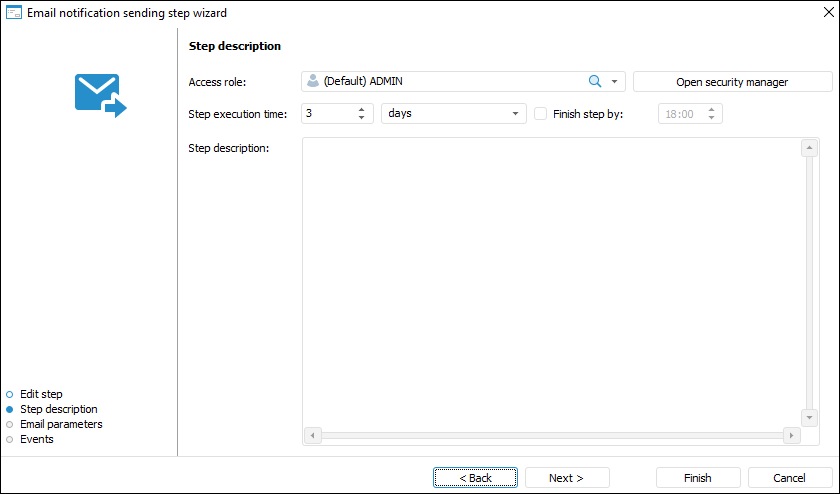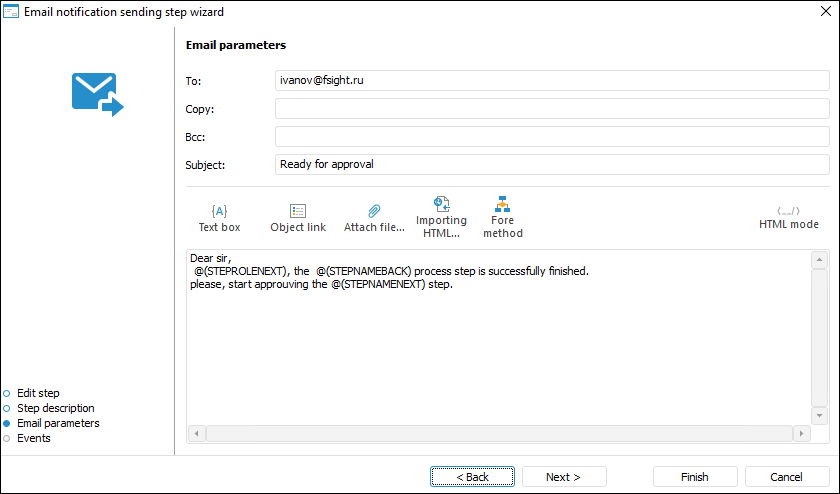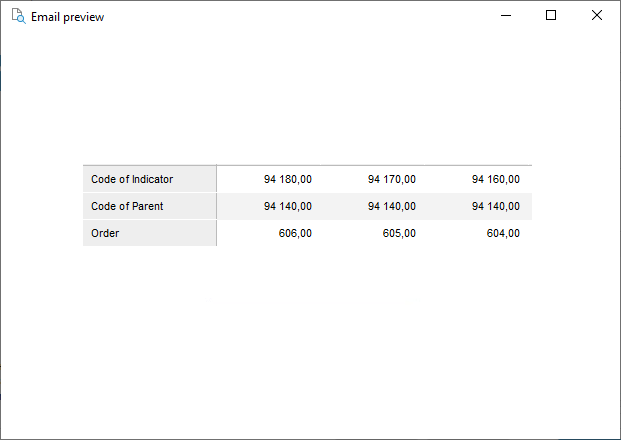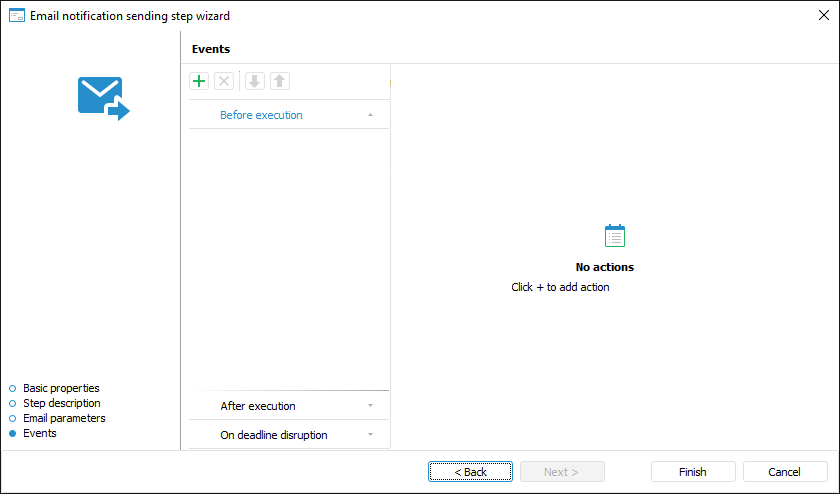In this article:
Creating the Send Email Notification Step
To work with the step for creating automatic email notifications open the send email notifications step wizard.
To send email notifications, one should set up send parameters on the Parameters page in the Parameters Setup and Business Processes Administration dialog box.
Setup of the Send Email Notifications step includes the following operations:
Set up basic step properties. After basic step properties have been determined, click the Next button.
Setting Up Step Description Parameters
To set up step description parameters, use the Step Description page in the step wizard:

Set the parameters:
Access Role. The box is mandatory. In the drop-down list select the owner role. The list contains roles of users specified in the authorization object. By default, the field contains the Admin user.
If the list does not contain the required group of users, click the Open Security Manager button. The dialog box of the security manager of Foresight Analytics Platform, which enables the user to create the required group of users.
Step Execution Time. Specify the time, in which a step should be executed on process execution. Execution time is counted from step activation.
Enter a numeric value of step execution time and select a time measurement unit in the list: minute, hour, day (default), week, month, quarter, half-year, or year.
To determine time, by which step must be finished, select the Finish Step By checkbox. When the Minute or Hour measurement units are selected, this box is hidden.
If the step is not finished by the scheduled execution period, the step status becomes Expired.
The step execution period impacts the whole process execution period, which is determined during process start.
Step Description. The box is optional. A text box for entering a comment for a step.
After the parameters have been determined on the Step Description page, click the Next button.
Email Parameters
To set up email parameters, use the Email Parameters page in the step wizard:

Set the parameters:
To; Copy; Bcc. The recipient email is entered manually, using option of copy/paste from clipboard.
Subject. The email subject is entered manually, using option of copy/paste from clipboard.
Contents. It is entered manually using the following options:
 Text Box. It opens the list of available variables. Variables values are generated depending on unique parameters of each process instance:
Text Box. It opens the list of available variables. Variables values are generated depending on unique parameters of each process instance:@(STEPROLEBACK). Previous step role. Type: string.
@(STEPNAMEBACK). Previous step name. Type: string.
@(STEPROLENEXT). Next step role. Type: string.
@(STEPNAMENEXT). Next step name. Type: string.
@(STEPNAME). Step name. Type: string.
@(PROCESSNAME). Process name. Type: string.
@(PROCESSCUSTOMER). Process manager. Type: string.
@(PROCESSSTARTTIME). Process start time. Type: date and time.
@(STEPDEADLINE). Step execution deadline. Type: date and time.
@(STEPBACKFINISHUSER). The user who executed previous manual step. Type: string.
@(STEPBACKFINISHCOMMENT). Comment for previous manual step execution. Type: string.
@(STEPDECLINEUSER). The user who rejected manual step. Type: string.
@(STEPDECLINECOMMENT). Comment for manual step rejection. Type: string.
NOTE. Viewing objects by link is executed in the web application. Make sure that the web application is created, there are objects in it, to which there are links, and the web application URL is specified on the Parameters page of the Parameters Setup and Business Processes Administration dialog box.
 Attach File. Files attachments to the mail. Available formats for attached files: image, MS Word and MS Excel documents.
Attach File. Files attachments to the mail. Available formats for attached files: image, MS Word and MS Excel documents.
NOTE. One email can contain maximum 10 attached files. There are constraints depending on the email service in use, for example, Gmail does not accept attached files size greater than 25 Mb.
 Import HTML. Inserting HTML file to the email contents. When loading HTML file, the
Import HTML. Inserting HTML file to the email contents. When loading HTML file, the  HTML Mode is activated by default and the Email Preview dialog box opens, for example:
HTML Mode is activated by default and the Email Preview dialog box opens, for example:

NOTE. When importing HTML file, the email contents is replaced by HTML code.
 Fore Method. Adding a method handler that starts on sending the email:
Fore Method. Adding a method handler that starts on sending the email:

Determine for the Fore method:
Assembly. Select Fore unit in the drop-down list. Search by unit name is available.
To edit the selected assembly, click the  button.
button.
To create a unit, click the  button.
button.
Method. Select method in the drop-down list. The list contains all unit methods corresponding to the signature:
Sub <Fore method name>(Sender: IBProcessInstance; Args: IBProcessEmailEventArgs);
Parameter:
Sender. Process instance.
Args. Event information: step, step old state, new state.
To refresh the methods list, click the  button.
button.
To copy method signature, click the  button.
button.
 HTML Mode. Enable/disable HTML mode. To open the email preview window, click the HTML Mode button and select the Preview Window checkbox.
HTML Mode. Enable/disable HTML mode. To open the email preview window, click the HTML Mode button and select the Preview Window checkbox.
NOTE. It is unavailable to insert images via HTML mode, use the  Attach File option.
Attach File option.
After the parameters have been determined on the Email Parameters page, click the Next button.
Setting Up Events Executed on Step Execution Start or End
To set up the events executed automatically on step execution start and end, use the Events page in the step wizard:

Create a list of executed operations:
Select the tab with the configured event on the Events wizard page. The following events are available:
Before Execution. The list of actions will be started before executing the current step in the specified order.
After Execution. The list of actions will be started after executing the current step in the specified order.
On Rejection. The list of actions will be started on the current step rejection. The list is available for steps with manual execution. If the step is executed automatically, the tab is not displayed.
On Deadline Disruption. The list of actions will be started on deadline disruption to execute the current step in the specified order. To execute the actions:
When the server execution of processes is selected, select the Check Deadline Disruption of Steps checkbox on the Scheduler page and set check frequency.
When the client execution of processes is selected, select the Check Deadline Disruption item on the Administration page.
Click the
 Add button on the toolbar and select the added action:
Add button on the toolbar and select the added action:
 Execute Fore Method. Determine:
Execute Fore Method. Determine:Unit. In the drop-down list select a unit written in the Fore language, the list contains all repository units and folders containing units. Search by unit name is available.
To edit the selected unit, click the  Edit button.
Edit button.
To create a unit, click the  Add button.
Add button.
Method. Select method in the drop-down list. The list contains all unit methods corresponding to the signature:
Sub <Fore-method name>(Sender: IBProcessInstance; Args: IBProcessStepStateEventArgs);
Parameter:
Sender. Process instance.
Args. Event information: step, step old state, new state.
To refresh the methods list, click the  Refresh List button.
Refresh List button.
To copy method signature, click the  Copy Signature button.
Copy Signature button.
 Send Email. Set message parameters:
Send Email. Set message parameters:To. Enter address of one or several main recipients separated by the ; character. The box is mandatory.
Copy. Enter address of one or several recipients separated by the ; character.
BCC. Enter address of one or several recipients separated by the ; character. The address will be hidden from other message recipients.
Subject. Enter message subject.
Contents. Enter message contents using the option of variables values substitution with step parameters, links to step objects to view in the web application, file attachments.
NOTE. The number of added actions is unlimited.
To reorder operation execution, use the  Move Up and
Move Up and  Move Down buttons on the toolbar on the Events wizard; to delete, click the
Move Down buttons on the toolbar on the Events wizard; to delete, click the  Delete button.
Delete button.
The list of automatically executed actions can be empty.
To determine parameters on the Events page, click the Finish button.
After creating the process steps, set up process steps execution conditions.

 Open the wizard
Open the wizard Object Link
Object Link